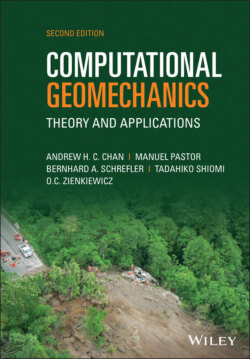Читать книгу Computational Geomechanics - Manuel Pastor - Страница 21
2.2.2 Simplified Equation Sets (u–p Form)
ОглавлениеThe governing equation set (2.11), (2.13), and (2.16) together with the auxiliary definition system can, of course, be used directly in numerical solution as shown by Zienkiewicz and Shiomi (1984). This system is suitable for explicit time‐stepping computation as shown by Sandhu and Wilson (1969) and Ghaboussi and Wilson (1972) and later by Chan et al. (1991). However, in implicit computation, where large algebraic equation systems arise, it is convenient to reduce the number of variables by neglecting the apparently small (underlined) terms of equations (2.11) and (2.13). These contain the variable wi(w) which now can be eliminated from the system.
The first equation of the reduced system becomes (from (2.11))
(2.20a)
or
(2.20b)
The second equation is obtained by coupling (2.13) and (2.16) using the definition (2.14) and thus eliminating the variable wi(w). We now have, omitting density changes
(2.21a)
or
(2.21b)
This reduced equation system is precisely the same as that used conventionally in the study of consolidation if the dynamic terms are omitted or even of static problems if the steady state is reached and all the time derivatives are reduced to zero. Thus, the formulation conveniently merges with procedures used for such analyses. However, some loss of accuracy will be evident for problems in which high‐frequency oscillations are important. As we shall show in the next section, these are of little importance for earthquake analyses.
In eliminating the variable wi(w), we have neglected several terms but have achieved an elimination of two or three variable sets depending on whether the two‐ or three‐dimensional problem is considered. However, another possibility exists for obtaining a reduced equation set without neglecting any terms provided that the fluid (i.e. water in this case) is compressible.
With such compressibility assumed, Equation (2.16) can be integrated in time, provided that we introduce the water displacement in place of the velocity wi(w). We define
(2.22a)
or
(2.22b)
where the division by the porosity n is introduced to approximate the true rather than the averaged fluid displacement. We now can rewrite (2.16) after integration with respect to time as
(2.23a)
or
(2.23b)
and thus we can eliminate p from (2.11) and (2.13).
The resulting system which is fully discussed in Zienkiewicz and Shiomi (1984) is not written down here as we shall derive this alternative form in Chapter 3 using the total displacement of water U = UR + u as the variable. It presents a very convenient basis for using a fully explicit temporal scheme of integration (see Chan et al. 1991) but it is not applicable for long‐term studies leading to steady‐state conditions, as the water displacement U then increases indefinitely.
It is fortunate that the inaccuracies of the u–p version are pronounced only in high‐frequency, short‐duration, phenomena, since, for such problems, we can conveniently use explicit temporal integration. Here a very small time increment can be used for the short time period considered (see Chapter 3).
Table 2.1 summarizes various forms of governing equations used.
